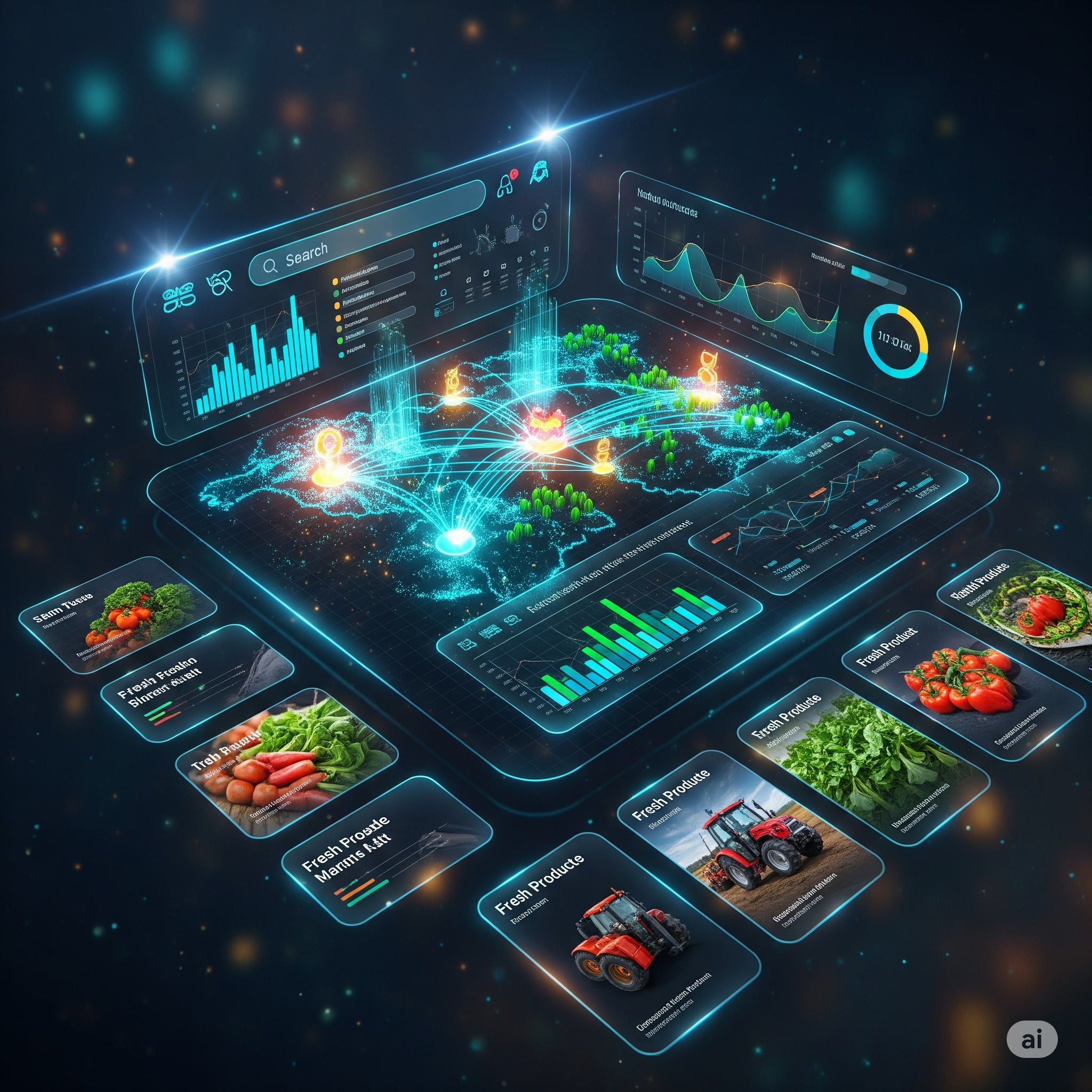Introduction
Agriculture is the backbone of the Indian economy, employing nearly 50% of the population. Despite producing one of the highest volumes of food in the world, Indian farmers often struggle with poor market access, low prices, and a lack of transparent information. Traditionally, agricultural marketing in India has been controlled by physical mandis (wholesale markets), where middlemen dominate pricing and distribution.
However, the digital age is changing the game. E-commerce and digital platforms for agricultural marketing are transforming how farmers connect with buyers, access information, and sell their produce. These tools are bridging gaps between rural farms and urban demand centers, making agriculture more profitable, inclusive, and efficient.
What Is E-Commerce in Agriculture?
E-commerce in agriculture refers to the use of digital platforms and online services to buy and sell agricultural products, including crops, livestock, fertilizers, machinery, and more. These platforms operate through websites, apps, or even SMS-based systems that allow farmers and buyers to connect directly without intermediaries.
The concept extends beyond simple transactions. It includes digital tools that offer market price updates, weather forecasts, advisory services, logistics management, and online payments.
Why Is Digital Agricultural Marketing Important?
- Direct Farmer-to-Consumer Linkage
Traditional supply chains involve many intermediaries, which reduces the share of income that reaches the farmer. Digital platforms reduce this chain, enabling farmers to sell directly to consumers, retailers, or businesses. - Price Transparency
Many digital platforms provide real-time price updates, allowing farmers to compare rates and choose the most profitable markets. - Reduced Post-Harvest Losses
With better logistics and faster market access, perishable goods can be sold quicker, reducing spoilage. - Access to a Wider Market
Farmers can reach urban consumers or even export markets without physically moving to large cities or markets. - Integrated Services
Platforms often bundle services such as soil testing, crop advisory, credit, insurance, and logistics—turning them into one-stop solutions.
How Do These Platforms Work?
A typical digital agricultural platform offers the following features:
- Registration/Login: Farmers sign up via mobile, web, or through village centers.
- Product Listings: They list their produce with quality, quantity, and expected price.
- Buyer Search: Retailers, wholesalers, or even households can browse and place orders.
- Logistics Support: Some platforms offer transport services or connect with third-party logistics.
- Payment Systems: Payments are often made through UPI, digital wallets, or bank transfers.
- Tracking and Feedback: Farmers can track their deliveries and receive buyer feedback.
Key Players in India’s Agri E-Commerce Space
1. e-NAM (National Agriculture Market)
A government initiative integrating over 1,000 physical mandis into a unified online platform. It allows farmers to sell produce across states and to multiple buyers, all from a mobile app or kiosk.
2. DeHaat
A private platform offering end-to-end solutions—input sales, crop advisory, and marketplace linkage. It supports smallholder farmers with a digital backbone.
3. Ninjacart
One of India’s largest agri-logistics platforms that connects farmers to retailers and restaurants in urban areas. It ensures better prices for farmers and quality produce for buyers.
4. AgriBazaar
An online marketplace for bulk trading of agricultural commodities. It also provides warehousing, grading, and payment services.
5. AgriApp, KisanMandi, and Farm2Fam
These platforms focus on niche products, including organic farming, B2B exports, or farmer co-operatives.
Benefits of E-Commerce for Different Stakeholders
✅ For Farmers
- Better pricing through competitive bidding
- Direct access to large buyers and even export markets
- Reduction in transportation and storage costs
- Timely payment and reduction in financial risk
✅ For Consumers
- Fresh produce at reasonable rates
- Assurance of traceability and quality
- Direct contribution to rural incomes and sustainability
✅ For Agribusinesses
- Reduced procurement costs
- Easier aggregation and tracking
- Faster market expansion and digital insights
Government Support and Policy Framework
The Indian government has taken several steps to encourage digital agriculture:
- Digital India Initiative: Promoting internet access and digital literacy in rural areas.
- PM-KISAN: A financial benefit scheme that’s now integrated with digital accounts for easy transfers.
- eNAM: Promoting interstate agricultural trade online.
- Agri Infrastructure Fund (AIF): Funding warehouses, cold chains, and logistics that digital platforms can utilize.
- FPO Promotion Scheme: Supporting Farmer Producer Organizations that can benefit from using digital tools collectively.
Technology Behind Agri E-Commerce
📱 Mobile Technology
Most farmers access digital platforms via mobile apps or feature phone-based services (like IVR or SMS). Voice-based interfaces are emerging for illiterate farmers.
☁️ Cloud Computing
Platforms use cloud systems to store farm data, transaction history, inventory, and logistics details securely and accessibly.
📍 Geolocation & GIS
Geo-tagging helps track farms, crop locations, and delivery addresses. It also aids in climate-based advisories.
🧠 AI & Machine Learning
These tools analyze weather, soil data, and market trends to recommend planting times, suggest fertilizers, or forecast prices.
🔒 Blockchain
Emerging platforms use blockchain to ensure transparent, tamper-proof records of transactions and traceability from farm to fork.
Challenges in Scaling E-Commerce in Agriculture
Despite the promise, several barriers remain:
⚠️ 1. Digital Literacy
A significant portion of India’s farmers lack the skills or confidence to use apps and online platforms.
⚠️ 2. Internet Connectivity
Rural connectivity, though improving, still lags behind in many states.
⚠️ 3. Trust Issues
Farmers are cautious about dealing with unknown online buyers. Building trust takes time.
⚠️ 4. Logistics Bottlenecks
Lack of proper roads, vehicles, or cold-chain infrastructure can prevent timely deliveries.
⚠️ 5. Regulatory Hurdles
State-wise APMC regulations and mandi fees may limit or slow down digital trade.
Real-Life Impact Stories
🌾 Farmer from Madhya Pradesh
Ramesh, a soybean farmer, used an app to check market prices across districts. He sold his produce via an e-NAM-linked mandi and earned 18% more than the local rate.
🍅 Tomato Grower in Karnataka
A woman farmer used Ninjacart to sell tomatoes directly to restaurants in Bengaluru, avoiding spoilage and saving transport costs.
🧺 FPO in Maharashtra
A Farmer Producer Organization used a WhatsApp-based marketplace to coordinate bulk sales of millets and received bulk orders from a retail chain.
Future Outlook: What Lies Ahead?
- Wider Use of Voice & Vernacular Platforms
Voice-activated services in regional languages will improve digital access for non-literate farmers. - Integration with ONDC
The government’s Open Network for Digital Commerce (ONDC) aims to make platforms interoperable, allowing farmers to sell across apps seamlessly. - Rise of Hyperlocal Platforms
Micro-marketplaces targeting villages or taluks will help farmers connect with buyers nearby. - Cross-Border Trade
Certified exporters will enable digital agricultural commerce to reach foreign buyers, boosting exports of spices, millets, and organic produce. - Carbon Credits & Sustainable Farming
Digital records of sustainable practices can help farmers earn carbon credits through blockchain-backed e-commerce platforms.
Conclusion
Digital agricultural marketing is not just a trend—it’s a revolution. By leveraging e-commerce platforms, Indian farmers can break free from traditional constraints and enter a new era of profitability, transparency, and empowerment.
However, for this transformation to be inclusive, it requires:
- Capacity building among farmers,
- Better infrastructure and internet,
- Collaborative partnerships between government, tech companies, and FPOs.
If implemented inclusively, e-commerce in agriculture could be the key to doubling farmer incomes, reducing food waste, and building a resilient, modern rural economy.




